Artisan sourdough bread crafted with a unique sweet levain is an interesting twist on your classic sourdough loaf. The sweet levain is made with an active sourdough starter, flour, water, and sugar. It doesn’t necessarily make the sourdough bread sweet but gives it a mild flavor while allowing for a long fermentation.
The end result is really something. The crumb is delectably soft and the crust holds all the flavor. The extended fermentation time in this method doesn’t produce an overly sour flavor. Instead, the bread ends up being pleasantly mild.
I was inspired by Addie Roberts known as the @breadstalker to try this method and it did not disappoint.

What is a sweet levain?
A sweet levain is a type of sourdough starter or pre-ferment that incorporates sugar into the mixture. Unlike traditional sourdough starters, which rely solely on flour and water, a sweet levain introduces sweetness, adding a deeper element to the bread.
This unique blend enhances the flavor profile, providing a delightful balance of tanginess from the sourdough culture and a touch of sweetness from the added sugars. The result is sourdough bread with a more nuanced and complex taste.
Will the bread be sweet?
The short answer is no. The sweet levain does not make this bread sweet. Instead, it allows for a long fermentation time without an overpowering sour flavor. As explained above it results in a complex flavor, which turns out to be one of the best ways I have personally enjoyed traditional sourdough bread.
The method calls for a very ripe levain, a long bulk rise at room temperature, and cold-proof. Not only does this enhance the overall flavor, but it results in an incredibly soft, airy crumb.

Pro tips before baking
- Make sure to look at my “baker’s schedule” note before you plan to bake. Every baker needs a game plan, and this method is a long-fermented one so having an idea of what your schedule will be is helpful!
- The sweet levain is made with a sourdough starter that is 100% hydration. This means it is fed in equal parts of water and flour. If you are using a sourdough starter that is not 100% hydration the timing may vary.
- The sweet levain takes around 13 hours to peak. My recommendation is to not rush this process. The longer it sits, the more flavor it holds and will give your bread.
- This sourdough bread was tested at 68 degrees F and required 8 hours of its first bulk rise. If your environment is warmer than this, it may not require as much time. If it is colder, it may require more than 8 hours. Watch the dough, not the clock.
How to make sourdough bread (with a sweet levain) step-by-step
Baker’s schedule:
1. Mix the sweet levain the evening before mixing the dough and allow the levain to ripen for 12-13 hours.
2. Mix the dough the following morning. The first bulk rise will be 8 hours at room temperature.
3. Cold-proof or refrigerate the dough for the second bulk rise for 12-18 hours (overnight) baking the bread immediately following this.
Ingredients & Equipment
For the sweet levain:
- 10 grams active sourdough starter at 100% hydration
- 40 grams water
- 40 grams of all-purpose flour
- 20 grams sugar
For the dough:
- 80 grams of sweet levain (from above)
- 328 grams water
- 450 grams of bread flour or a strong all-purpose flour
- 9 grams salt
You will need:
- Dutch oven or cast iron
- Mixing bowl
- Bench scraper
- Scoring tool or sharp knife
- Food scale
- Parchment paper
- Banneton proofing basket
Make the sweet levain
- The evening before you plan to bake, add the sourdough starter, sugar, and water to a clean jar. Stir until the starter and sugar dissolve and the water becomes milky.
- Next, add the flour and stir until there are no dry bits of flour left. Loosely cover the jar and allow the levain to rest for 12-13 hours.
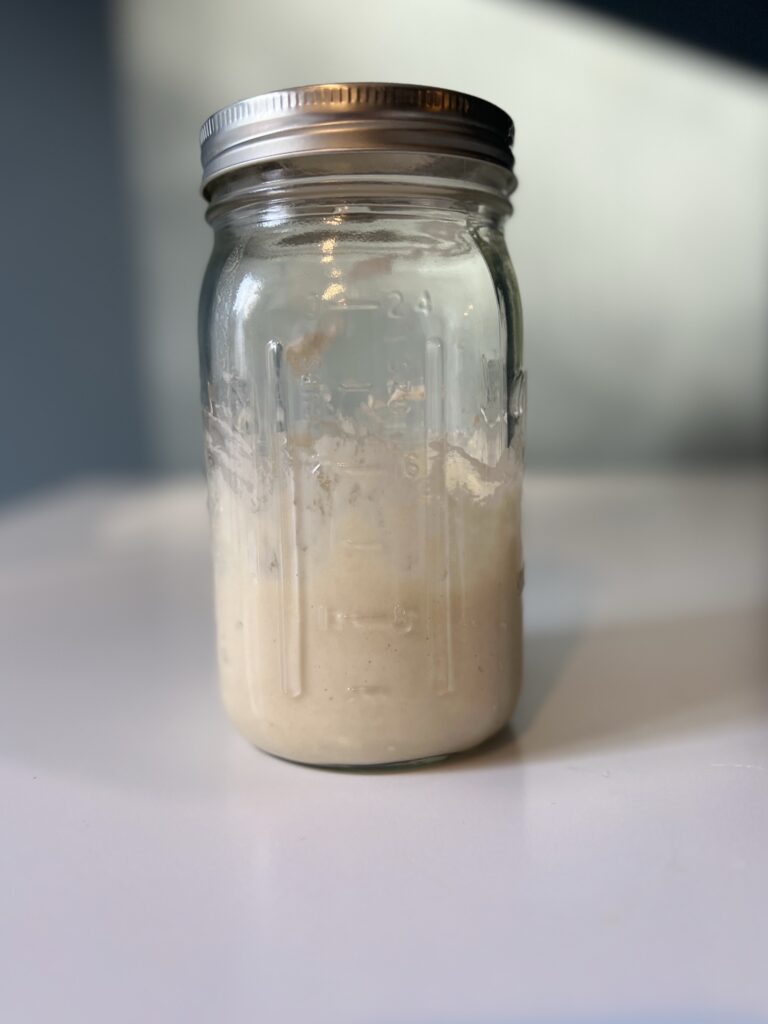
Mix the dough
- After the levain has doubled in size and is bubbly, prepare to mix the dough.
- To a mixing bowl add the water, and all of the sweet levain (should amount to 80 grams) there may be extra stuck to the sides of the jar, try to keep it no more than 90 grams. Stir with a fork until the levain has dissolved.
- Add the flour and mix until all of the flour has absorbed the water. We are purposely leaving out the salt during this phase.
- The dough will be wet & shaggy. Cover it with plastic wrap or a damp towel and allow it to rest for 30-45 minutes.
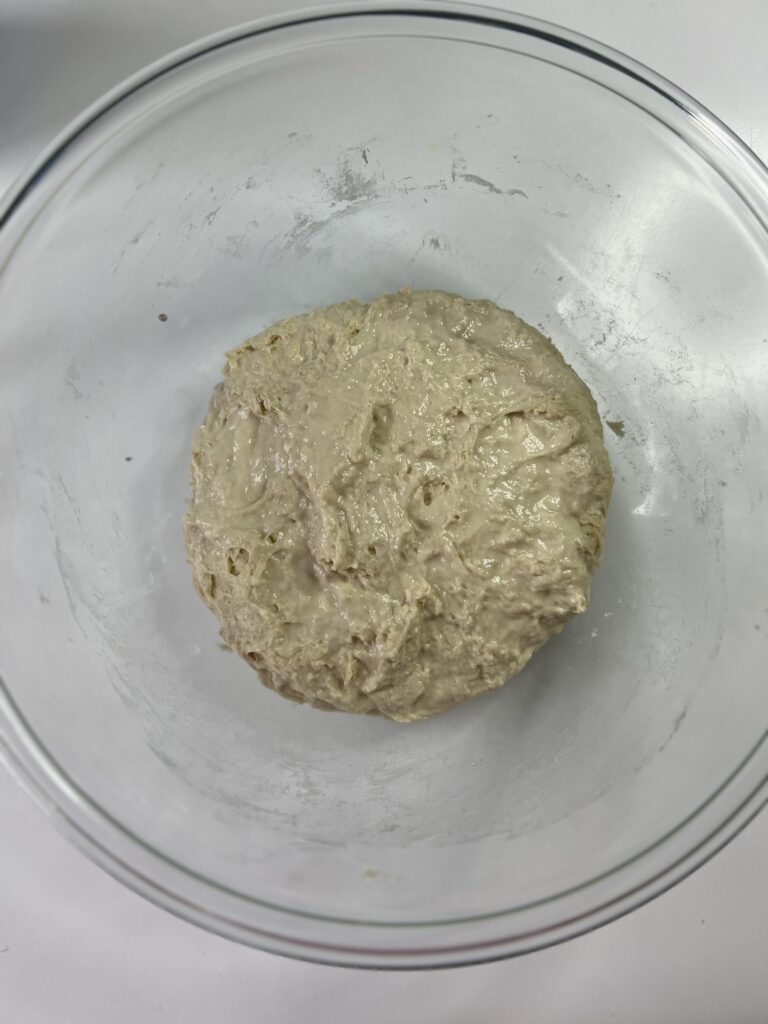
Add the salt
- After the dough has rested sprinkle the salt over top of it and dimple it into the mixture.
- To ensure the salt gets mixed in and to create some strength in the dough, fold it into itself repetitively & slap it against the bowl for a few minutes.
- The dough will appear smoother, but still quite sticky. This is normal. Cover the bowl with plastic wrap again and let it rest for 30 minutes.
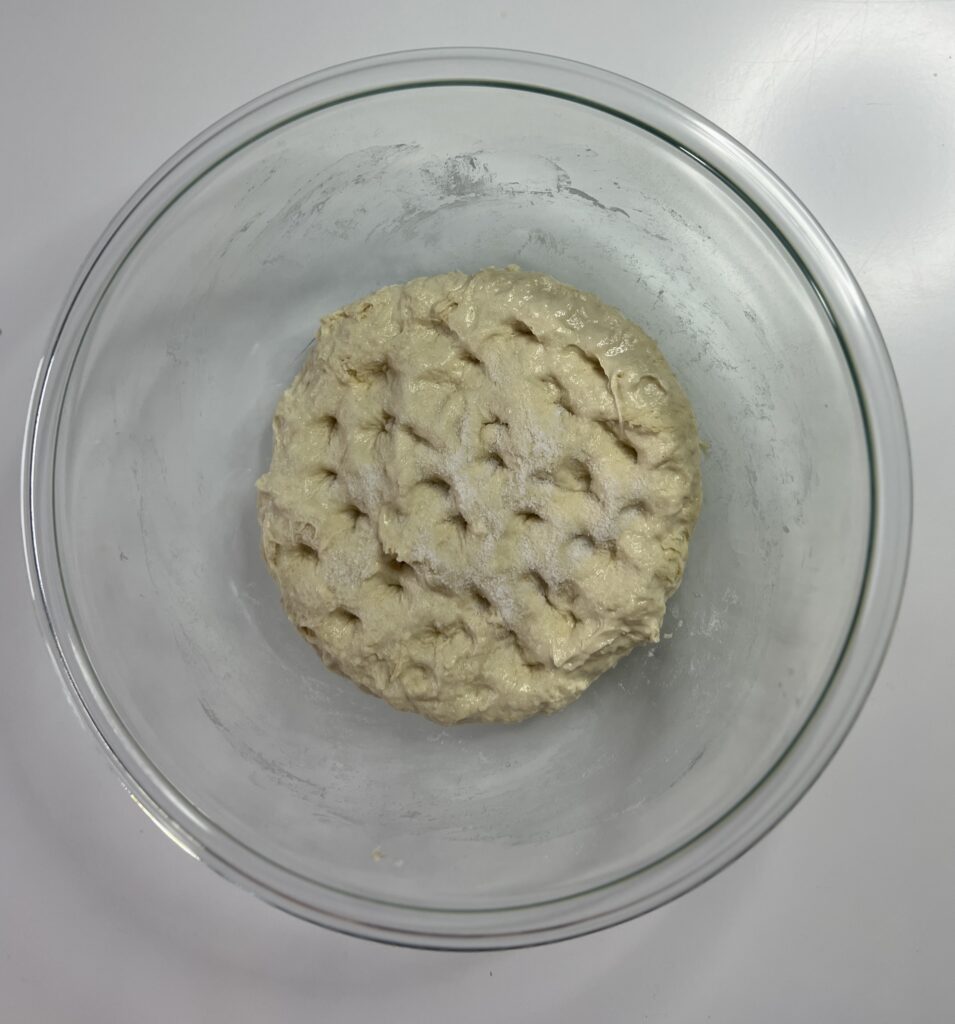
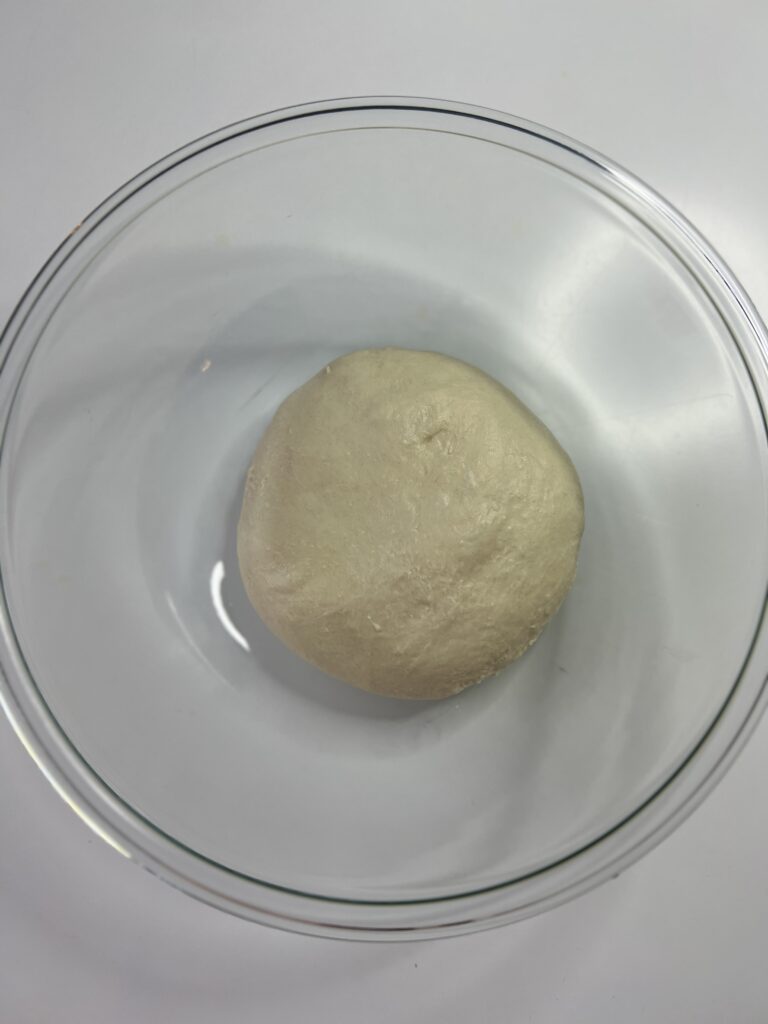
Coil Folds
Coil folding is a technique used in sourdough bread making to strengthen the dough and improve its structure. I prefer this method for this recipe as it is a softer approach.
Tip: lightly wet your hands to avoid the dough sticking to them.
- Gently reach under the dough with your wet hands and lift it up.
- Stretch the dough upwards, then fold it under the center of itself.
- Turn the dough 90 degrees and repeat the lifting and stretching process.
- You can continue to turn the dough and fold it a few times, usually 4-5 times in total, to make a complete “coil.”
- Once complete, cover the dough and allow it to rest for 30 minutes.
- Perform 4 more coil folds within 30-minute increments totaling 5 coil folds. This will ensure the dough develops enough structure.
- Once all coil folds have been completed, cover the dough and allow it to rest for the remaining bulk rise (approximately 3-4 more hours).
Pre-shape the dough
- After the dough has rested for at least 7-8 hours total, it can be pre-shaped.
- Place the dough on a lightly floured surface and create a round shape by using your bench scraper. See the video below for a demonstration.
- To create a round shape place the bench scraper under the bottom part of the dough and use a circular motion. Do this repetitively until you get the desired shape. The tension will naturally settle in the middle of the dough, giving it a better oven spring when baked. You can also do this motion using your hands.
- After a round ball shape has been created, cover the dough with a towel or bowl and let it rest for 15 minutes.
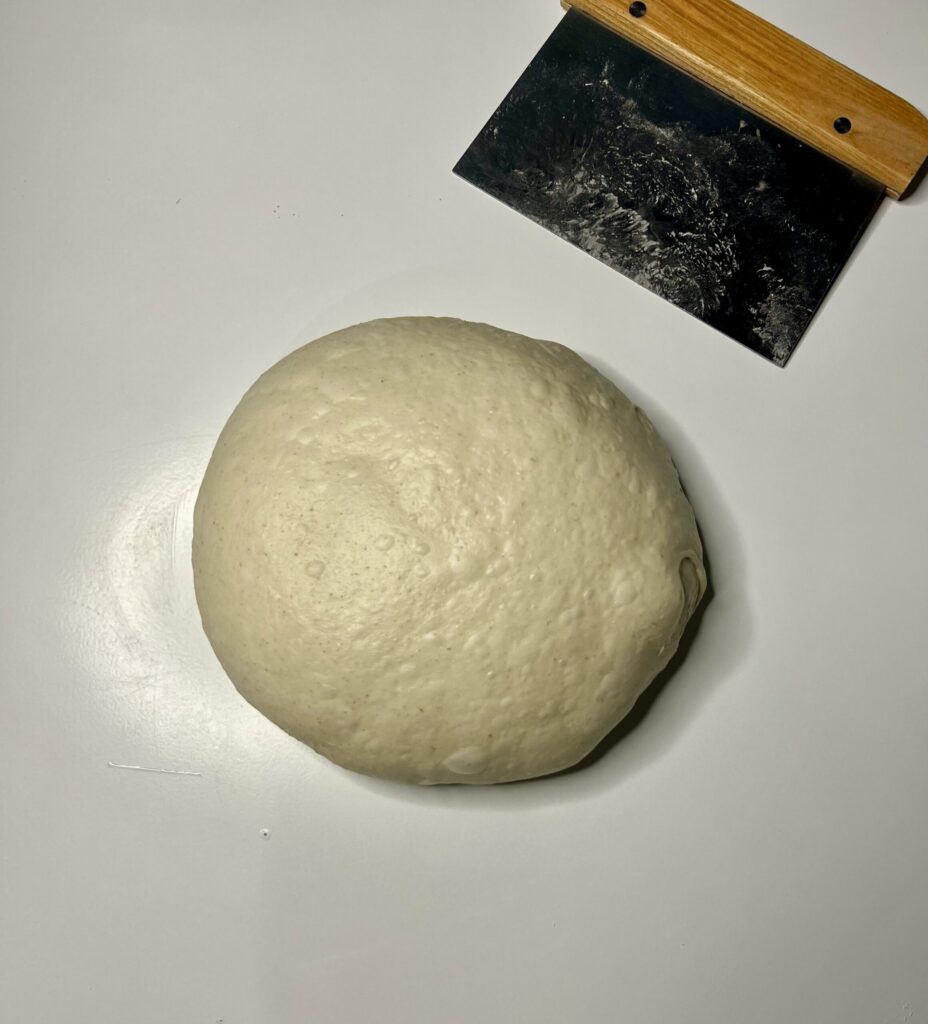
Final Shaping
- When it comes to the final shaping, you have the choice of creating a round boule or an oval batard.
- I will offer instructional videos for both shaping options, allowing you to pick the one that suits you best.
- After shaping, position the dough in the banneton basket with the seam facing upwards. If necessary, you can gently stitch or tighten the seams while in the basket.
- Now, cover the dough either with a cloth or by placing it inside a 2.5-gallon bag. Then, transfer it to the refrigerator and let it rest for 12-18 hours.
How to shape a round boule
How to shape an oval batard
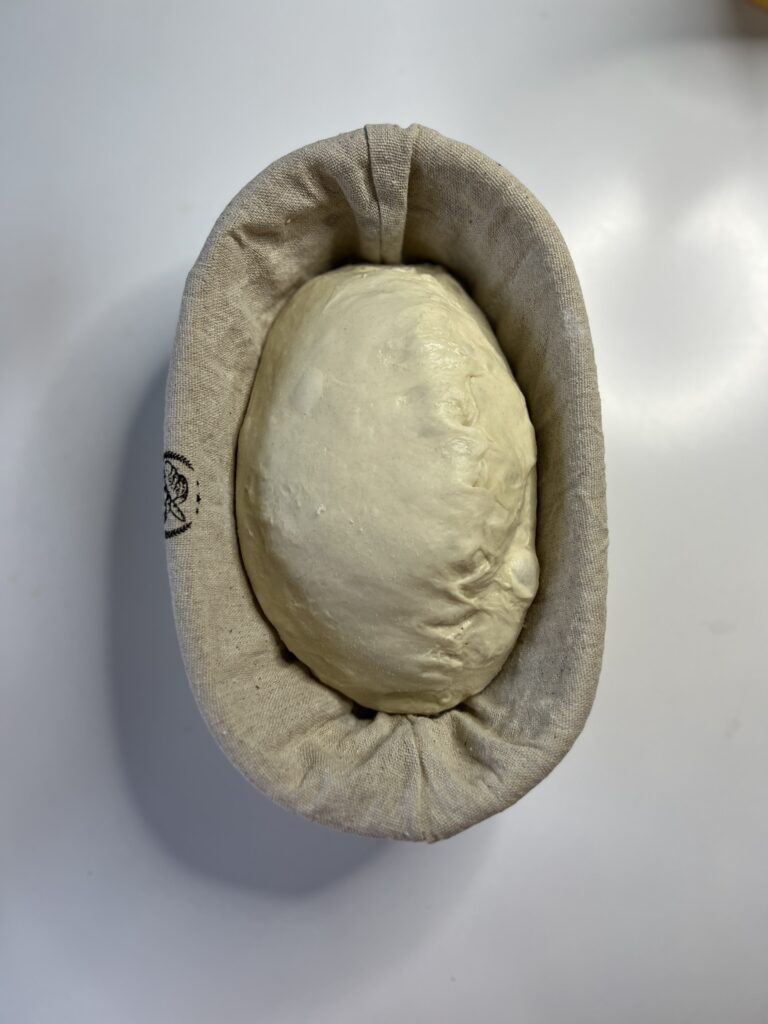
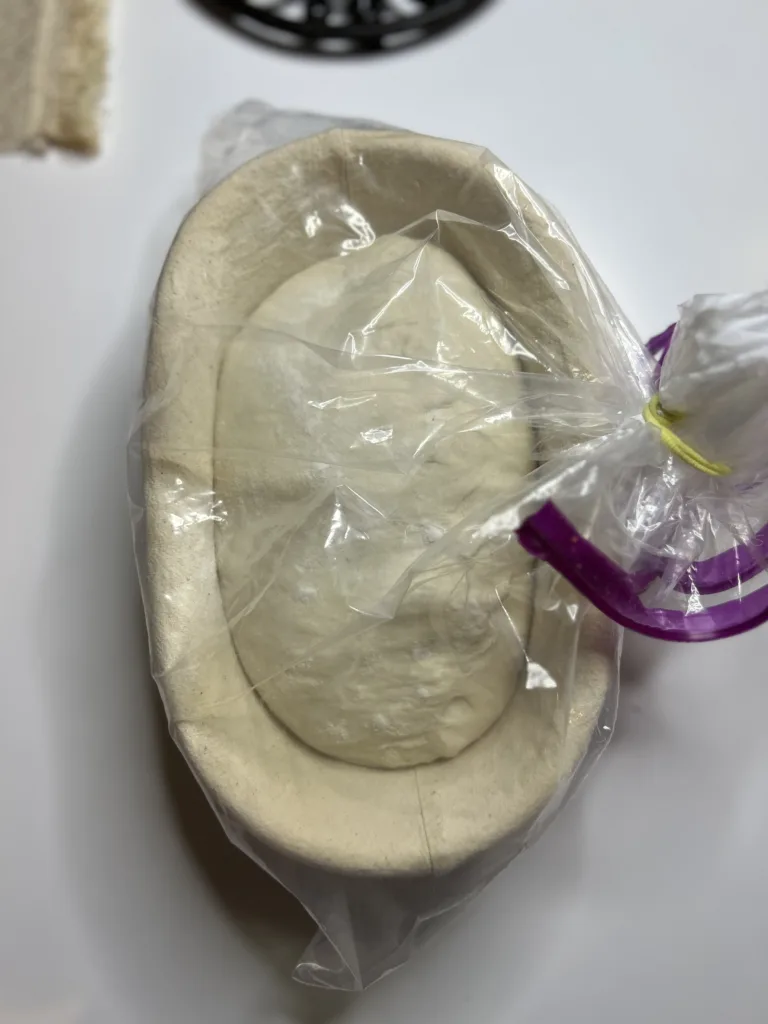
Score & Bake
- For an optimal rise, I recommend preheating the oven to 500 degrees F for 30 minutes with the baking vessel in there.
- When ready to bake, remove the dough from the fridge and invert it onto a piece of parchment paper.
- With a sharp knife or bread lame score 1 slightly curved line down the dough.
- Transfer the dough to the Dutch oven using the parchment paper and bake covered for 20 minutes at 500 degrees F. Optional: place 2 ice cubes into the Dutch oven to create steam.
- After 20 minutes, remove the lid, decrease the temperature to 450 degrees F, and bake for another 15 minutes.
- Allow the bread to cool completely before slicing into it (about 1-2 hours).

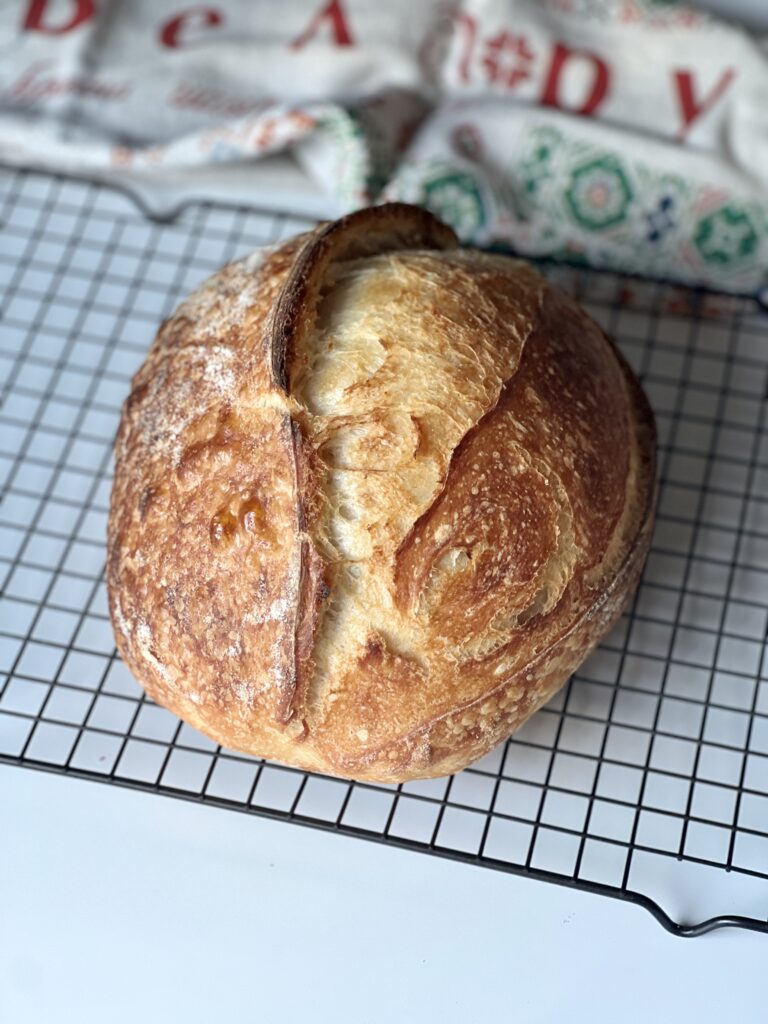
Storing sourdough bread
- Allow the bread to cool completely before slicing and storing it.
- Sourdough bread lasts 2-3 days at room temperature and stores well in a paper or plastic bag.
- Additionally, you can freeze a loaf for up to 3 months. Slice it before freezing so you can take out individual slices as needed. Wrap the slices tightly in plastic wrap or aluminum foil and place them in a freezer bag. Frozen sourdough bread can be reheated directly in a toaster or oven.
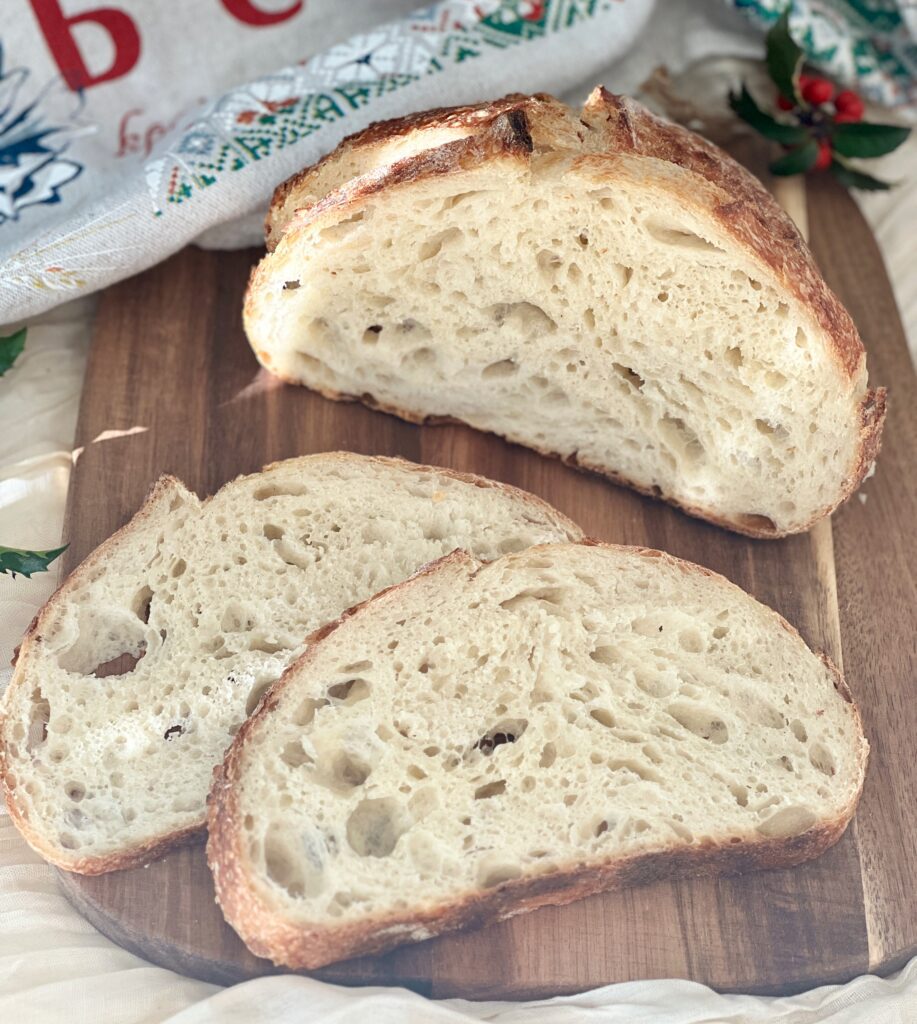
More sourdough bread recipes:
- Simple Sourdough Recipe
- Sourdough Italian Bread
- Sourdough Ciabatta Bread
- Chocolate Chip Sourdough Bread (with honey!)
Sourdough Bread (with a sweet levain)
Equipment
- Dutch oven or cast iron
- Mixing bowl
- Bench scraper
- Scoring tool or sharp knife
- Food scale
- Parchment paper
- Banneton Proofing Basket
Ingredients
For the sweet levain
- 10 grams active sourdough starter
- 40 grams water
- 40 grams all-purpose flour
- 20 grams sugar
For the dough
- 80 grams sweet levain from above
- 328 grams water
- 450 grams bread flour or a strong all-purpose flour
- 9 grams salt
Instructions
Make the sweet levain
- The evening before you plan to bake add the sourdough starter, sugar, and water to a clean jar. Stir until the starter and sugar dissolve and the water becomes milky.
- Next, add the flour and stir until there are no dry bits of flour left. Loosely cover the jar and allow the levain to rest for 12-13 hours.
Mix the dough
- After the levain has doubled in size and is bubbly, prepare to mix the dough.
- To a mixing bowl add the water, and all of the sweet levain (should amount to 80 grams) there may be extra stuck to the sides of the jar, try to keep it no more than 90 grams. Stir with a fork until the levain has dissolved.
- Add the flour and mix until all of the flour has absorbed the water. We are purposely leaving out the salt during this phase.
- The dough will be wet & shaggy. Cover it with plastic wrap or a damp towel and allow it to rest for 30-45 minutes.
Add the salt
- After the dough has rested sprinkle the salt over top of it and dimple it into the mixture.
- To ensure the salt gets mixed in and to create some strength in the dough, fold it into itself repetitively & slap it against the bowl for a few minutes.
- The dough will appear smoother, but still quite sticky. This is normal. Cover the bowl with plastic wrap again and let it rest for 30 minutes.
Coil Folds
- Coil folding is a technique used in sourdough bread making to strengthen the dough and improve its structure. I prefer this method for this recipe as it is a softer approach to this delicate bread. Tip: lightly wet your hands to avoid the dough sticking to them.
- Gently reach under the dough with your wet hands and lift it up.
- Stretch the dough upwards, then fold it under the center of itself.
- Turn the dough 90 degrees and repeat the lifting and stretching process.
- You can continue to turn the dough and fold it a few times, usually 4-5 times in total, to make a complete “coil.”
- Once complete, cover the dough and allow it to rest for 30 minutes.
- Perform 4 more coil folds within 30-minute increments totaling 5 coil folds. This will ensure the dough develops enough structure.
- Once all coil folds have been completed, cover the dough and allow it to rest for the remaining bulk rise (approximately 3-4 more hours).
Pre-shape the dough
- After the dough has rested for at least 7-8 hours total, it can be pre-shaped.
- Place the dough on a lightly floured surface and create a round shape by using your bench scraper.
- To create a round shape place the bench scraper under the bottom part of the dough and use a circular motion. Do this repetitively until you get the desired shape. The tension will naturally settle in the middle of the dough, giving it a better oven spring when baked. You can also do this motion using your hands.
- After a round ball shape has been created, cover the dough with a towel or bowl and let it rest for 15 minutes.
Final-shaping
- When it comes to the final shaping, you have the choice of creating a round boule or an oval batard.
- After shaping, position the dough in the banneton basket with the seam facing upwards. If necessary, you can gently stitch or tighten the seams while in the basket.
- Now, cover the dough either with a cloth or by placing it inside a 2.5-gallon bag. Then, transfer it to the refrigerator and let it rest for 12-18 hours.
Score & Bake
- For an optimal rise, I recommend preheating the oven to 500 degrees F for 30 minutes with the baking vessel in there.
- When ready to bake, remove the dough from the fridge and invert it onto a piece of parchment paper.
- With a sharp knife or bread lame score 1 slightly curved line down the dough.
- Transfer the dough to the Dutch oven using the parchment paper and bake covered for 20 minutes at 500 degrees F. Optional: place 2 ice cubes into the dutch oven to create steam.
- After 20 minutes, remove the lid, decrease the temperature to 450 degrees F, and bake for another 15 minutes.
- Allow the bread to cool completely before slicing into it (about 1-2 hours).
- Sourdough bread lasts 2-3 days at room temperature and stores well in a paper or plastic bag.
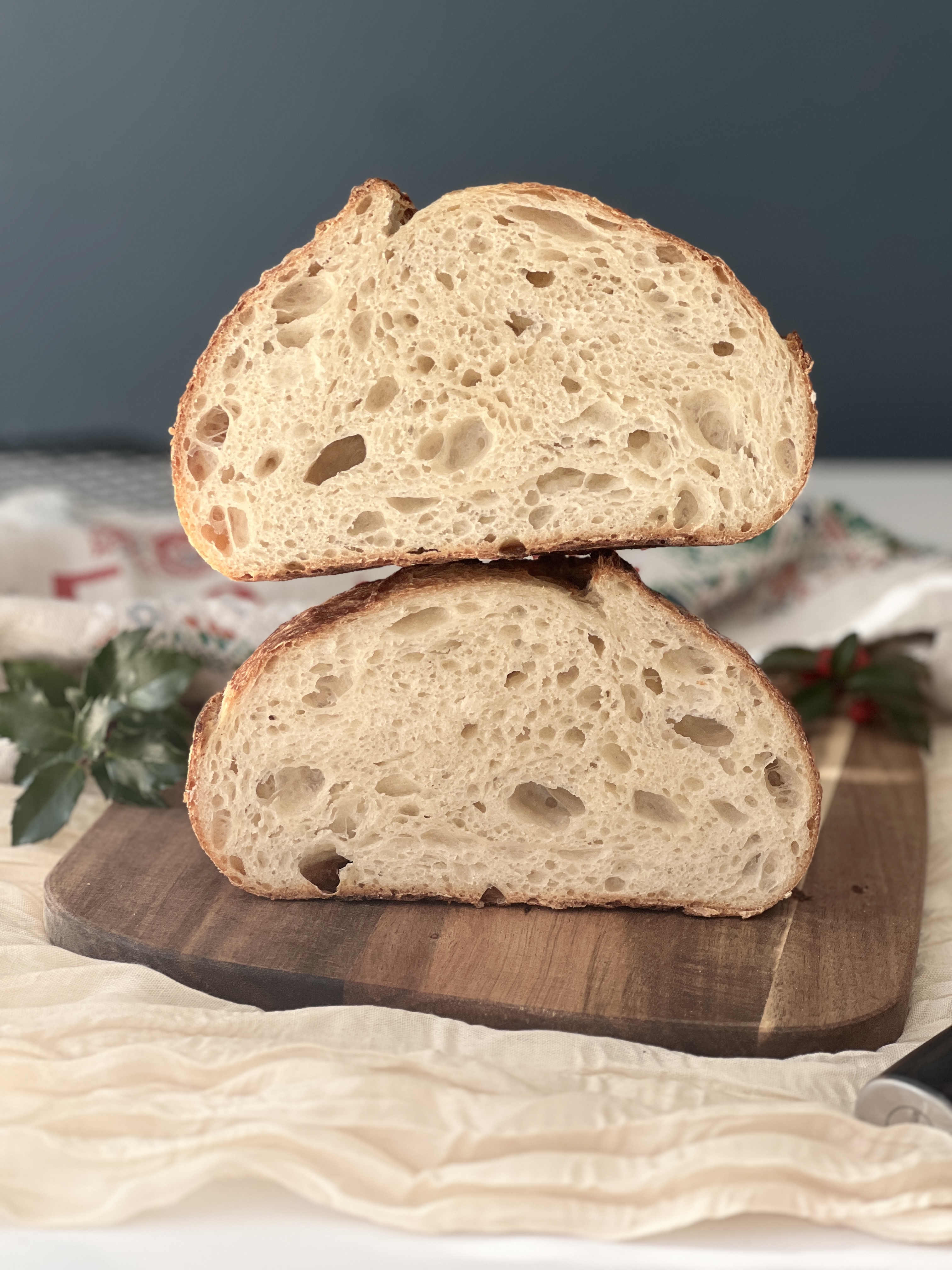

Leave a Comment & Rate the Recipe